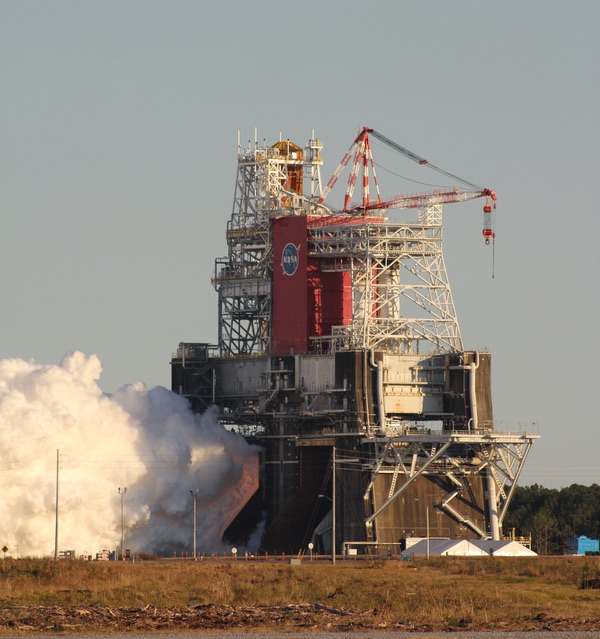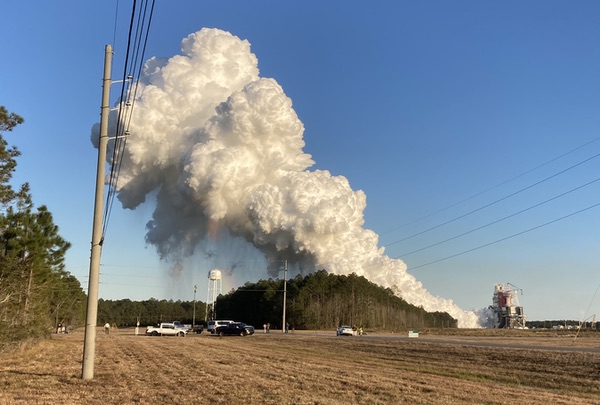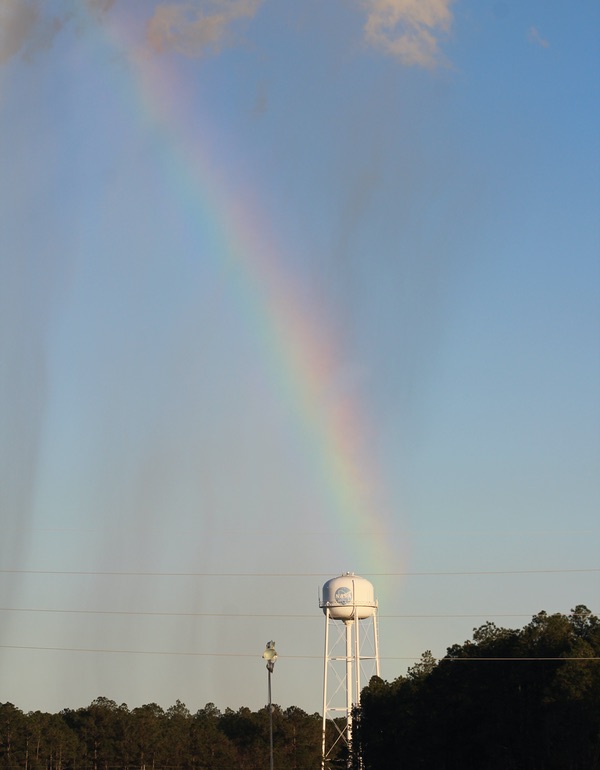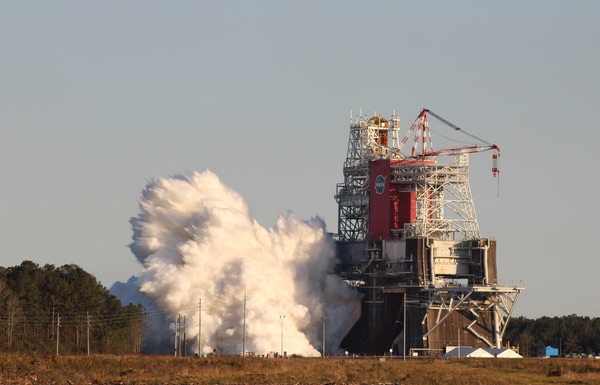Green Run, yellow lightby Jeff Foust
|
| “It’s been tough,” said Lueders. “I didn’t know we were going to have five hurricanes this summer, along with COVID and a few other things.” |
This year, though, was supposed to be the year for SLS. NASA entered 2021 holding on to a November 2021 launch date for Artemis 1, the first SLS mission, carrying an uncrewed Orion spacecraft. The Orion for that mission is assembled, and late last week was handed over to processing team at the Kennedy Space Center for fueling and other pre-launch preparations. Much of the SLS is also at KSC, including the segments for the twin solid rocket boosters and its upper stage.
What the Artemis 1 mission is waiting for is the core stage of the SLS, based on the shuttle’s external fuel tank but with four RS-25 engines in its base. The core stage has spent the last year at the Stennis Space Center in Mississippi going through a series of tests known as the Green Run. That test campaign was to culminate last weekend with a full-duration static firing of the core stage on a test stand there, a milestone it needed to perform before it could be shipped to KSC to prepare, just maybe, for a launch late this year.
 Closeup of the B-2 test stand during the Green Run test January 16. (credit: J. Foust) |
Leadup to the Green Run
While the Green Run has been most closely associated with the static-fire test, it encompasses a much wider range of tests that started one year ago, when the core stage arrived at Stennis from the Michoud Assembly Facility in New Orleans. Once installed on the B-2 test stand, it went through eight major tests, including checks of its avionics and hydraulics as well as a practice countdown. The last two tests were a “wet dress rehearsal,” where the core stage is loaded with liquid hydrogen and liquid oxygen components, and then the full-duration static fire test.
When the core stage arrived at Stennis, NASA hoped to get through the Green Run tests by late summer, allowing the core stage to ship to the Kennedy Space Center in the fall for Artemis 1 launch preparations. However, that schedule didn’t survive the coronavirus pandemic, which closed Stennis for two months in the spring. Several hurricanes and tropical storms passed close enough to Stennis in the spring and fall to close the center for days at the time, interrupting testing.
“It’s been tough,” said Kathy Lueders, NASA associate administrator for human explorations and operations, at a meeting last week of two committees of the NASA Advisory Council. “I didn’t know we were going to have five hurricanes this summer, along with COVID and a few other things.”
The core stage itself, though, also had technical issues. In early December, NASA started the wet dress rehearsal, but stopped in its early stages. The problem, agency officials said in a call with reporters a few days later, was that liquid oxygen flowing into the core stage was slightly warmer than required, an issue they blamed on the test facilities and nor the stage itself.
| “My confidence has gone up significantly,” Honeycutt said in December. “In all likelihood, we’re not going to have a big issue that causes us to stand down for any significant amount of time.” |
A second wet dress rehearsal took place December 20. That test didn’t have propellant temperature issues, and the core stage took its full load of liquid oxygen and liquid oxygen without any leaks. However, while the wet dress rehearsal featured a simulated countdown that would stop at about T-30 seconds, the test was stopped several minutes before that.
At a briefing last week, John Shannon, vice president and general manager of SLS at Boeing, the prime contractor for the stage, said that liquid hydrogen fill-and-drain valve closed 0.2 seconds later. The valve is pneumatically operated, and the helium used for it was colder than expected, slowing the closure of the valve. The solution, he said, was simply to adjust the timing in the software. “We don’t have to be quite that precise and cut it quite that close, so we expanded the timer out so we’ve got sufficient margin,” he said.
Despite the glitches, SLS managers were optimistic going into the Green Run hotfire test. “My confidence has gone up significantly,” John Honeycutt, NASA SLS program manager, said during a December briefing. “I think we’re at a point now where we’re likely to see some small things that we may have to go work, but I think the team’s done an outstanding job and we’ve learned enough to know that, in all likelihood, we’re not going to have a big issue that causes us to stand down for any significant amount of time.”
 The plume from the Green Run test. (credit: J. Foust) |
The big day
NASA was confident going into the final Green Run test. It scheduled the test for January 17, but earlier in the week moved it up a day because preparations were moving ahead of schedule. On the afternoon of the test, NASA announced it was moving it up an hour, as propellant loading and other activities were, at the time, going smoothly.
Had the test happened a year ago, there may have been a much larger crowd at Stennis, but NASA limited the number of media and other guests allowed on site because of the pandemic. It didn’t deter some people from trying to see the test: on the side of the highway leading to the center’s main gate, a car was parked with two lawn chairs set up beside it, able to see the B-2 test stand in the distance through a clearing.
While NASA had been moving ahead swiftly through test preparations earlier in the day, they ran into issues that caused them to move the test back by more than an hour. NASA provided few details about the cause of the delays at the time, but Honeycutt said after the test there was an “engine conditioning challenge” on one engine, as well as problem maintaining liquid hydrogen tank pressurization because a valve wasn’t responding as expected. (The latter issue wasn’t detected in the wet dress rehearsals, he said, since the countdowns did not get far enough along before other issues stopped them.)
| “I know not everybody is feeling as happy as we otherwise could because we wanted to get eight minutes of a hotfire and we got over a minute,” Bridenstine said. |
Those issues were resolved, and the countdown continued. The four RS-25 engines ignited in sequence, 120 milliseconds apart, and throttled up to 109% of rated thrust. The engines formed a plume of steam, a cloud billowing out from the base of the test stand. Staff at the observing area, a couple kilometers from the stand, had handed out hearing protection for guests, but the vibration turned out to be far more noticeable than the sound.
The planned duration of the test was 485 seconds, the same length the engines would fire on a launch. Most of the key data for the test, though, would be collected in the first half, as the engines throttled down to 95% and then back to 109% as they would when passing through max-q, or maximum dynamic pressure, in flight. The engines would also gimbal several times during the test.
“If we had an early shutdown for whatever reason, we get all of the engineering data that we need to have high confidence in the vehicle at about 250 seconds,” Shannon said at a briefing last week. He added, though, that “we’re going to go ahead and put it through the entire flight profile as long as everything is looking okay.”
But just a little more than a minute into the test, the vibration stopped and the cloud now towering over the test stand lost its source of steam. The engines had shut down, but it wasn’t clear why.
The only hint in a NASA TV webcast was one test controller reporting an MCF, or major component failure, in engine number four. That took place about 45 to 50 seconds into the test, but the engines didn’t shut down until 67.2 seconds after ignition, as NASA administrator Jim Bridenstine reported the next day.
At a briefing two and a half hours after the test, Bridenstine and Honeycutt had little to add about exactly what happened. “When I left the team a little while ago, they were still beginning to pore through the data, and we will continue to do that over the next several days,” Honeycutt said.
He mentioned the MCF, but said that alone said little about what happened. “Any parameter that went awry on the engine could send that failure ID, but at the time that they made the call we did still have four good engines up and running at 109%.”
There was, Honeycutt noted, another issue: a “little bit of a flash” seen around thermal protection blankets where engine number four connects to the base of the vehicle. That took place around 60 seconds after ignition, seconds before shutdown. He didn’t have additional details about what caused the flash.
The truncated test was a disappointment, Bridenstine admitted. “I know not everybody is feeling as happy as we otherwise could because we wanted to get eight minutes of a hotfire and we got over a minute,” he said.
However, he remained almost fiercely optimistic, suggesting that, even though the test fell well short of the 250 seconds previously identified as effectively a minimum for the test to be successful, there might not be a need to do the hotfire test again. “It depends what the anomaly was and how challenging it’s going to be to fix it,” he said. “I think it very well could be that it’s something that’s easily fixable and we can feel confident going down to the Cape and staying on schedule.”
“We have said all along that we would like to get at least to 250 seconds. But I think we need to do our due diligence and go look at the data that we’ve collected to ensure that we’ve got a good plan moving forward,” Honeycutt said.
It was unclear how long it would take for NASA to determine when, or even if, another hotfire test was needed. Honeycutt said it would take 21 to 30 days to complete post-test inspections and other work on the core stage before being ready to fire again if no other work was needed.
 Will there be a pot of gold for the SLS at the end of this rainbow created by the Green Run test? (credit: J. Foust) |
The future of SLS
Had the Green Run test gone as expected, NASA planned to take the core stage down from the stand, place it on a barge, and transport it to KSC in February, keeping alive a 2021 first launch. That schedule seems in jeopardy, but Bridenstine wouldn’t rule out a launch this year.
“What is the probability of that? I honestly don’t know. I don’t think anybody at this point knows,” he said in brief comments after the briefing Saturday. “I don’t want to count it out at this point.”
| “Given the amount of effort and time and investment that has already been made, let’s just get it over the finish line,” Bridenstine said. |
That decision won’t be his to make. Bridenstine’s tenure as NASA administrator ends on Wednesday, at the end of the Trump Administration. The Biden Administration, and whomever it selects to lead the agency, will face decisions ranging from when to launch Artemis 1 to whether to continue the program at all.
The slow rate of progress may make SLS a tempting target. However, the vehicle still has powerful supporters on Capitol Hill, including Sen. Richard Shelby (R-AL), top Republican on the Senate Appropriations Committee. While no longer in the majority, Shelby will still be influential in a committee divided, like the Senate, 50-50.
In the House, Rep. Robert Aderholt (R-AL) returns as the top Republican on the House Appropriations Committee’s commerce, justice, and science, subcommittee, which funds NASA. While the House remains in Democratic control, in deliberations on the fiscal year 2021 budget last year, it was the House that offered slightly more money for SLS than the Senate—$2.6 billion versus $2.586 billion—with both figures well above the administration’s request for about $2.26 billion.
Another supporter of SLS in the Senate is Sen. Roger Wicker (R-MS), top Republican on the Senate Commerce Committee, whose oversight includes NASA and who was at Stennis for the test. In a statement afterwards, he seemed undeterred by its limited duration. “We are still on track to take the first woman to the moon by 2024 and complete a Mars landing by 2029. I know that bipartisan support for this program and space exploration will certainly continue,” he said.
A 2024 human lunar landing is almost certainly off the table after Congress provided NASA with only a quarter of its requested funding for the Human Landing System lunar lander program. His comments about a Mars landing in 2029, a goal not stated by NASA in recent memory, are a mystery.
Bridenstine said after the briefing he still believes SLS is the best option for returning humans to the Moon as soon as possible, even if that’s not 2024. “NASA needs to go back and look at what the options are for going to the Moon as quickly as possible. I think that the SLS rocket is going to be that option,” he said. “If we’re talking about sending humans to the Moon, that’s the highest probability of success at the earliest possible moment.”
“Given the amount of effort and time and investment that has already been made, let’s just get it over the finish line,” he added.
Work on SLS will continue, for now, even if the prospects of a launch this year recede. At the NASA Advisory Council meeting last week, Lueders said she was hoping, once the core stage arrives at KSC, to avoid similar weather delays like those that delayed the Green Run work at Stennis last year. “I told folks if this core stage goes to the Cape and I have five hurricanes next summer,” she said, “I’m going to bring in the exorcist.”
Now might be a good time to get referrals for an exorcist, in any case.
Note: we are temporarily moderating all comments submitted to deal with a surge in spam.
